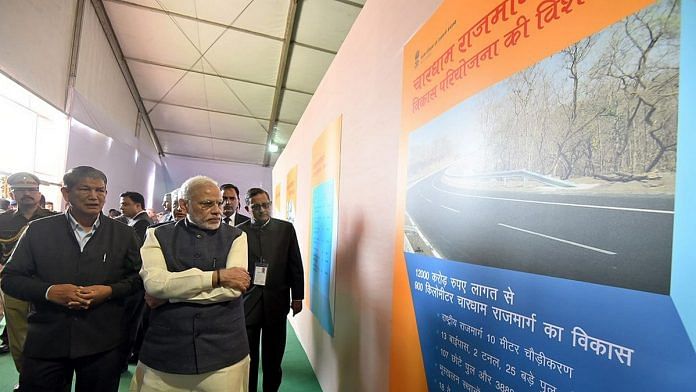New Delhi: The Union Ministry of Road, Transport and Highways (MoRTH) has told the Supreme Court that its 2018 guidelines on the construction of roads in hilly and mountainous terrains was issued without keeping the strategic requirements of the military in mind.
The ministry also asked the top court to accept the majority view of the High-Powered Committee (HPC), which was set up by the SC last year, that has favoured a 10-metre carriageway for the strategic roads that are part of the 189-km Char Dham road project.
The Rs 12,000-crore Char Dham project aims to increase connectivity of the four Hindu pilgrimage sites — Gangotri, Yamunotri, Kedarnath and Badrinath — in Uttarakhand.
On 8 September 2020, the Supreme Court had ordered that the road width on the entire Char Dham route, which falls in the ecologically fragile Himalayan region, should be 5.5 metres, according to the standards laid down by the highway ministry’s March 2018 circular.
However, in a report submitted in December last year, 21 members of the 26-member HPC noted that it was not feasible to revisit the project — where the work was already completed to reduce the road width — in accordance to the SC order.
The committee’s chairman Ravi Chopra, a noted environmentalist, and two other members had dissented from the majority view and noted that keeping the road width 10 metres will have a “long term impact on the fragile Himalayan terrain and the sensitive Himalayan ecosystem”.
The highway ministry’s submission, which was filed on 31 December 2020, however, highlighted that its 2018 guidelines did not keep in “mind the strategic requirement for movement in military vehicles”, especially in the region leading to international borders.
The affidavit is part of an ongoing case between a Dehradun-based NGO, Citizens for Doon, and the central government on the Char Dham project. The SC bench led by Justice R.F. Nariman Monday asked the petitioner NGO to respond to the ministry’s affidavit.
Also read: Split in SC panel on Char Dham project, 21 of 26 members are against reducing road width
Ministry modifies guidelines to consider strategic importance of roads
According to the affidavit, “Standards for lane width of National Highways and roads developed under Central Sector Schemes in Hilly and Mountainous terrains” laid down in 2018 were general in nature and were based on passenger-car per unit (PCU) traffic and applicable to all the hilly areas in the country.
The highways ministry, however, did not have in mind the strategic requirement for movement of military vehicles with heavy equipment especially in the Himalayan region leading to international borders, the Line of Actual Control as well as for roads identified as economic corridors.
In its affidavit, the ministry said that it had now modified its guidelines, considering the peculiarities of the Himalayan region in the state of Uttarakhand and strategic importance of roads and highways in this region.
The MoRTH also referred to the HPC’s majority view and said the committee had taken a holistic view of the situation, keeping in mind the social, economic and strategic needs of the country.
According to HPC’s broad recommendations, mentioned in the affidavit, with the Uttarakhand government’s focus on reversing migration in border areas, wider roads in these locations will improve livelihood opportunities and also ease living conditions.
The report has further noted that no landslides have occurred in stretches where fresh road cutting has been carried out. Therefore, using the best available technology is needed to avoid any landslides to meet the requirements of defence forces and local people.
SC had asked HPC to consider defence, road ministry applications
On 2 December, a bench led by Justice Nariman had directed HPC to convene a meeting to consider the applications by the defence and road ministries, requesting it to modify its 8 September order to change the road width of the Char Dham project.
Citing serious repercussions on the defence of the country and its security interests, which “is in jeopardy especially in the background of today’s sensitive situation existing at the Chinese border”, the ministries had requested to allow two-lane road with 7-metre width in some parts of the 816-kilometre Char Dham highway.
Also read: Govt wants adultery to stay criminalised for armed forces, challenges 2018 SC verdict




So, this is how our supreme Jokers spend their time, debating on the width of a road? A supreme joker run banana republic we are
The experts claiming “long term impact on the fragile Himalayan terrain and the sensitive Himalayan ecosystem”. must accept that it will have to be handled with best technologies. So start working on that instead of blocking the project.
If the type of equipment needed to protect the borders has to move on these roads, the width had to be decided accordingly and not by ecological considerations. We must protect the region from the aggressors first and worry about long term effects later.